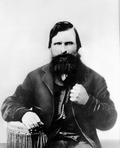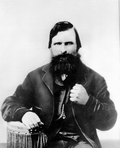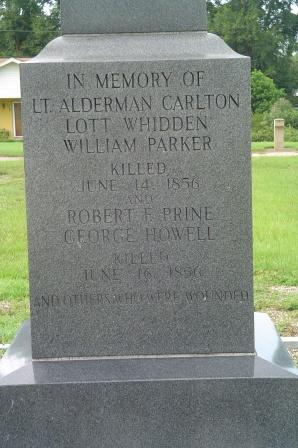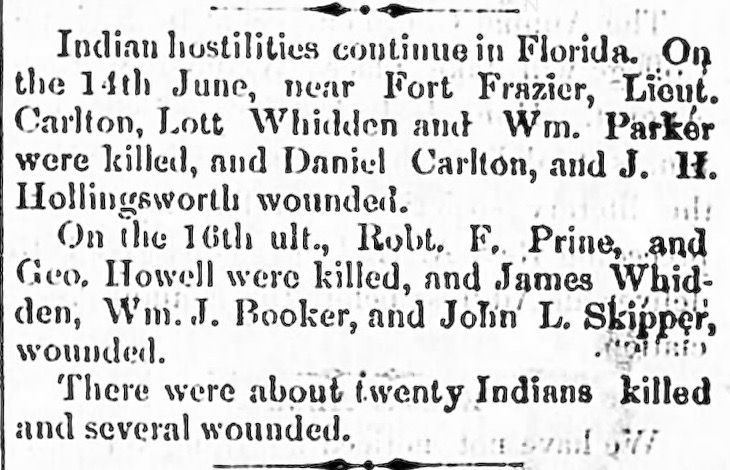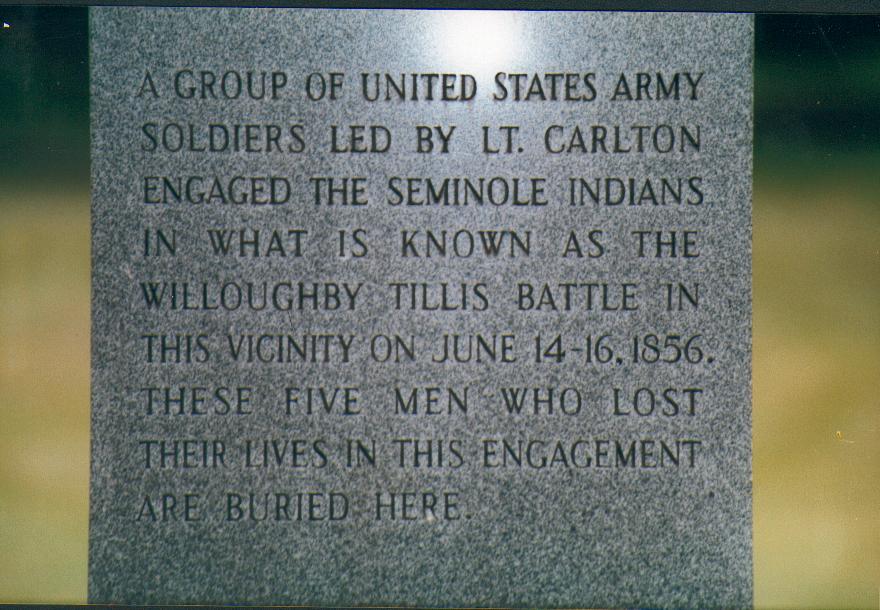CARLTON MOSTLY KNOWN FOR HIS DEATH
Some people become well known for the way they live -- their contributions to society, their military service, or their general success in life.
Others are regarded for their families -- those they were descended from, or those who came behind them.
By those measures, Alderman Carlton, who homesteaded near Fort Meade in the 1840s and 1850s, would rightfully deserve recognition.
Yet Carlton receives only passing recognition for his accomplishments. Instead, he seems best known for his death, riding to the rescue in one of the most storied battles in Polk County history.
"In the spring of 1856 he was commander of the garrison at Fort Meade and led six men to the defense of the Indian-besieged Willoughby Tillis family," Spessard Stone wrote for the Sunland Tribune in 1998. "In so doing, he was slain, as were two of his men, William Parker and Lott Whidden."
Born in Sampson County, N.C., in January 1803, Alderman Carlton was the third of nine children born to John and Nancy Ann Carlton, Stone wrote. The youngster, who was named in honor of his mother's family, the Aldermans, was descended from historic stock: both his grandfathers served in the Revolutionary War.
Carlton grew up in North Carolina and at age 19 married his mother's niece, Martha. The couple spent nearly 20 years living in Thomas County, Ga., where Carlton saw service in the Second Seminole War, before they moved to Florida.
It was the Armed Occupation Act of 1842 that brought the Carltons to Central Florida, Stone wrote. The Congressional act offered 160 acres of unoccupied Florida to any settler willing to defend their new homestead for five years. Carlton received one of the 1,184 homesteading permits issued.
Carlton received his permit in today's Alachua County, but within a short time was living as a planter and cattleman at the Alafia Settlement in eastern Hillsborough County. He stayed less than a decade before moving to the area of today's Homeland.
It was a move that was likely his undoing. When the Third Seminole War broke out in 1855, Carlton -- now in his early 50s -- joined Capt. Francis Durrance's militia company as a second lieutenant, Stone wrote.
Carlton was visiting family near Fort Meade in June 1856, when his eldest son, 32-year-old Daniel, reported that his own two young sons had heard gunfire in the woods while driving their cattle to pasture, James Dallas Tillis told the Florida Historical Quarterly in 1930. The lieutenant immediately gathered six militiamen, including Daniel, to investigate.
They arrived at Willoughby Tillis' homestead near Fort Meade to discover the family was under attack by a group of Seminoles lead by Oscen Tustenuggee, Canter Brown Jr. wrote in "Fort Meade: 1849-1900." The family was trapped in the house, exchanging gunfire with the Seminoles outside.
Upon arrival, the militiamen charged the Seminoles. There were soon casualties on both sides, Stone wrote in another story about Daniel Wilson Carlton on his "Cracker Barrel" history site.
"Lt. Carlton ... was shot down, and gave his gun to (John Oates), saying, 'I am done, take my gun and kill one,'" Stone wrote, quoting Capt. William B. Hooker's report of the battle.
Carlton was one of three early pioneers killed in the initial battle; two others died the next day. Carlton, William Parker, Lott Whidden, Robert Prine and George Howell were later buried in a common grave in Fort Meade, Brown wrote.
Today, Carlton's name is rarely mentioned in history books other than his role in the Battle of Peace Creek. Stone seems to be the only historian who has built a complete narrative of Carlton's life.
Yet Carlton's name has lived on in Florida for more than 150 years. His descendants include a number of historically significant Central Florida residents, including Florida Gov. Doyle Carlton (1929-33.
Polk Chronicles
By Cinnamon Bair
THE LEDGER
Published: Tuesday, February 21, 2012
[Cinnamon Bair, a Polk County native, can be reached at HYPERLINK "mailto:[email protected]" [email protected]. ]
________________________________________________________
________________________________________________________
Alderman Carlton was born January 4, 1803 to John and Nancy Ann, in Sampson County, North Carolina.
He married his first cousin, Martha Maria Alderman, born March 3, 1806, in Duplin County, North Carolina, daughter of Daniel and Mary Wilson Alderman.
Thomas Carleton, his grandfather, was born May 10, 1747. He and his wife, Martha (1751-1797), lived in Duplin County, North Carolina during the Revolutionary War, at which time he rendered service as a private. Thomas died October 3, 1795 in Duplin County. In his will Thomas made mention of prior modest bequests to his daughters, Rachel, Anna, Elizabeth, Lydia, and son, John, with his "dearly beloved wife, Martha, all the rest of any property both and stocks of all kinds and negroes her lifetime," except after her death, his sons, Stephen and Thomas, to inherit separate lands. (2)
About 1825, Alderman and family moved to Thomas County, Georgia. During the Second Seminole War, Alderman was a member of the companies commanded by Capt. Tucker and Capt. Browning, which were raised in August and September 1836. He participated in the Battle of Brushy Creek in Lowndes County, Georgia
Alderman, under provisions of the Armed Occupation Act of 1842, received on May 10, 1843 at Newnansville, Fla. permit # 414 for land, which was probably in Alachua County. Alderman later removed to the Alafia Settlement in Hillsborough County where he was a planter. During the Indian trouble in 1849, he served as fourth sergeant in Capt. John Parker's Company, organized July 1849. In 1851 city commissioners of Tampa deeded to L. G. Lesley, Dr. F. Branch, W. B. Hooker, Alderman Carlton and C. A. Ramsey, trustees for the First Methodist Church of Tampa, Lot 3 of Block 14 of the survey of 1847. On July 3, 1852, he registered the following mark & brand: undersquare and underbit in one ear and undersquare in the other brand "C."
Alderman in late 1854 or early 1855 moved his family near the Campground branch on the Fort Meade and Fort Frazier road. During the Third Seminole War on December 29, 1855, he was mustered into service as second lieutenant in Capt. Francis M. Durrance's Company. In the spring of 1856 he was commander of the garrison at Fort Meade and led six men to the defense of the Indian-besieged Willoughby Tillis family. In so doing, he was slain, as were two of his men, William Parker and Lott Whidden, while his son, Daniel W. Carlton, John C. Oats and John Henry Hollingsworth, were wounded.
This spacious memorial marks the burial place of five militiamen killed in the "Battle of Fort Meade" on June 14 and 16, 1856.
More than a century after this event the descendents of Alderman Carlton proposed a monument to commenmorate the graves. Apparently there was a grudge against one of the settlers, Willoughby Tillis who was living southeast of Fort Meade and building a new home there. When Celia Durrance, his wife went out to milk on June 14, she saw Indians hiding along the cattlepens, ran safely to the house with her servant and two sons, and the men in the house began the battle that drew the militia. The whole story is told in detail by James W. Covington "An Episode in the Third Seminole War." The Florida Quarterly, July 1966. p45. Also, "Florida's Peace River Frontier" by Canter Brown, Jr.
Alderman and Martha Carlton had 14 children, Daniel Wilson (1823-91); (2) Mary Ann (1825-93, Mrs. Timothy Alderman of Ga.); (3) William Thomas (1827-91 of Alachua Co.); (4) Martha Jane (1829-95, Mrs. J. M. Hayman of Bartow); (5) Elizabeth (1831-31); (6) Manerva (1833-42); (7) Isaac (1835-97 of Hillsborough Co.); (8) Priscilla (1837-1919, Mrs. Eli English of Wauchula); (9) Susannah (1839-78; who married G. H. Johnson and Rev. Robert N. Pylant of Bartow); (10) Missouri (1841-43); (11) Sarah (1844-87, who married Stephen P. Hooker and William C. Hayman of Owens); (12) Georgia Ann (1846-?, Mrs. Robert A. Carson of Immokalee); (13) Thomas C. (1850-50); (14) Nancy (1851-51).(11)
CARLTON MOSTLY KNOWN FOR HIS DEATH
Some people become well known for the way they live -- their contributions to society, their military service, or their general success in life.
Others are regarded for their families -- those they were descended from, or those who came behind them.
By those measures, Alderman Carlton, who homesteaded near Fort Meade in the 1840s and 1850s, would rightfully deserve recognition.
Yet Carlton receives only passing recognition for his accomplishments. Instead, he seems best known for his death, riding to the rescue in one of the most storied battles in Polk County history.
"In the spring of 1856 he was commander of the garrison at Fort Meade and led six men to the defense of the Indian-besieged Willoughby Tillis family," Spessard Stone wrote for the Sunland Tribune in 1998. "In so doing, he was slain, as were two of his men, William Parker and Lott Whidden."
Born in Sampson County, N.C., in January 1803, Alderman Carlton was the third of nine children born to John and Nancy Ann Carlton, Stone wrote. The youngster, who was named in honor of his mother's family, the Aldermans, was descended from historic stock: both his grandfathers served in the Revolutionary War.
Carlton grew up in North Carolina and at age 19 married his mother's niece, Martha. The couple spent nearly 20 years living in Thomas County, Ga., where Carlton saw service in the Second Seminole War, before they moved to Florida.
It was the Armed Occupation Act of 1842 that brought the Carltons to Central Florida, Stone wrote. The Congressional act offered 160 acres of unoccupied Florida to any settler willing to defend their new homestead for five years. Carlton received one of the 1,184 homesteading permits issued.
Carlton received his permit in today's Alachua County, but within a short time was living as a planter and cattleman at the Alafia Settlement in eastern Hillsborough County. He stayed less than a decade before moving to the area of today's Homeland.
It was a move that was likely his undoing. When the Third Seminole War broke out in 1855, Carlton -- now in his early 50s -- joined Capt. Francis Durrance's militia company as a second lieutenant, Stone wrote.
Carlton was visiting family near Fort Meade in June 1856, when his eldest son, 32-year-old Daniel, reported that his own two young sons had heard gunfire in the woods while driving their cattle to pasture, James Dallas Tillis told the Florida Historical Quarterly in 1930. The lieutenant immediately gathered six militiamen, including Daniel, to investigate.
They arrived at Willoughby Tillis' homestead near Fort Meade to discover the family was under attack by a group of Seminoles lead by Oscen Tustenuggee, Canter Brown Jr. wrote in "Fort Meade: 1849-1900." The family was trapped in the house, exchanging gunfire with the Seminoles outside.
Upon arrival, the militiamen charged the Seminoles. There were soon casualties on both sides, Stone wrote in another story about Daniel Wilson Carlton on his "Cracker Barrel" history site.
"Lt. Carlton ... was shot down, and gave his gun to (John Oates), saying, 'I am done, take my gun and kill one,'" Stone wrote, quoting Capt. William B. Hooker's report of the battle.
Carlton was one of three early pioneers killed in the initial battle; two others died the next day. Carlton, William Parker, Lott Whidden, Robert Prine and George Howell were later buried in a common grave in Fort Meade, Brown wrote.
Today, Carlton's name is rarely mentioned in history books other than his role in the Battle of Peace Creek. Stone seems to be the only historian who has built a complete narrative of Carlton's life.
Yet Carlton's name has lived on in Florida for more than 150 years. His descendants include a number of historically significant Central Florida residents, including Florida Gov. Doyle Carlton (1929-33.
Polk Chronicles
By Cinnamon Bair
THE LEDGER
Published: Tuesday, February 21, 2012
[Cinnamon Bair, a Polk County native, can be reached at HYPERLINK "mailto:[email protected]" [email protected]. ]
________________________________________________________
________________________________________________________
Alderman Carlton was born January 4, 1803 to John and Nancy Ann, in Sampson County, North Carolina.
He married his first cousin, Martha Maria Alderman, born March 3, 1806, in Duplin County, North Carolina, daughter of Daniel and Mary Wilson Alderman.
Thomas Carleton, his grandfather, was born May 10, 1747. He and his wife, Martha (1751-1797), lived in Duplin County, North Carolina during the Revolutionary War, at which time he rendered service as a private. Thomas died October 3, 1795 in Duplin County. In his will Thomas made mention of prior modest bequests to his daughters, Rachel, Anna, Elizabeth, Lydia, and son, John, with his "dearly beloved wife, Martha, all the rest of any property both and stocks of all kinds and negroes her lifetime," except after her death, his sons, Stephen and Thomas, to inherit separate lands. (2)
About 1825, Alderman and family moved to Thomas County, Georgia. During the Second Seminole War, Alderman was a member of the companies commanded by Capt. Tucker and Capt. Browning, which were raised in August and September 1836. He participated in the Battle of Brushy Creek in Lowndes County, Georgia
Alderman, under provisions of the Armed Occupation Act of 1842, received on May 10, 1843 at Newnansville, Fla. permit # 414 for land, which was probably in Alachua County. Alderman later removed to the Alafia Settlement in Hillsborough County where he was a planter. During the Indian trouble in 1849, he served as fourth sergeant in Capt. John Parker's Company, organized July 1849. In 1851 city commissioners of Tampa deeded to L. G. Lesley, Dr. F. Branch, W. B. Hooker, Alderman Carlton and C. A. Ramsey, trustees for the First Methodist Church of Tampa, Lot 3 of Block 14 of the survey of 1847. On July 3, 1852, he registered the following mark & brand: undersquare and underbit in one ear and undersquare in the other brand "C."
Alderman in late 1854 or early 1855 moved his family near the Campground branch on the Fort Meade and Fort Frazier road. During the Third Seminole War on December 29, 1855, he was mustered into service as second lieutenant in Capt. Francis M. Durrance's Company. In the spring of 1856 he was commander of the garrison at Fort Meade and led six men to the defense of the Indian-besieged Willoughby Tillis family. In so doing, he was slain, as were two of his men, William Parker and Lott Whidden, while his son, Daniel W. Carlton, John C. Oats and John Henry Hollingsworth, were wounded.
This spacious memorial marks the burial place of five militiamen killed in the "Battle of Fort Meade" on June 14 and 16, 1856.
More than a century after this event the descendents of Alderman Carlton proposed a monument to commenmorate the graves. Apparently there was a grudge against one of the settlers, Willoughby Tillis who was living southeast of Fort Meade and building a new home there. When Celia Durrance, his wife went out to milk on June 14, she saw Indians hiding along the cattlepens, ran safely to the house with her servant and two sons, and the men in the house began the battle that drew the militia. The whole story is told in detail by James W. Covington "An Episode in the Third Seminole War." The Florida Quarterly, July 1966. p45. Also, "Florida's Peace River Frontier" by Canter Brown, Jr.
Alderman and Martha Carlton had 14 children, Daniel Wilson (1823-91); (2) Mary Ann (1825-93, Mrs. Timothy Alderman of Ga.); (3) William Thomas (1827-91 of Alachua Co.); (4) Martha Jane (1829-95, Mrs. J. M. Hayman of Bartow); (5) Elizabeth (1831-31); (6) Manerva (1833-42); (7) Isaac (1835-97 of Hillsborough Co.); (8) Priscilla (1837-1919, Mrs. Eli English of Wauchula); (9) Susannah (1839-78; who married G. H. Johnson and Rev. Robert N. Pylant of Bartow); (10) Missouri (1841-43); (11) Sarah (1844-87, who married Stephen P. Hooker and William C. Hayman of Owens); (12) Georgia Ann (1846-?, Mrs. Robert A. Carson of Immokalee); (13) Thomas C. (1850-50); (14) Nancy (1851-51).(11)
Gravesite Details
Notices / Changes / Corrections, please email [email protected]
Family Members
-
![]()
Daniel Wilson Carlton
1823–1891
-
![]()
Mary Ann Carlton Alderman
1825–1893
-
![]()
William Thomas Carlton
1827–1891
-
![]()
Martha Jane Carlton Hayman
1830–1895
-
Elizabeth Carlton
1831–1831
-
Manerva Carlton
1833–1842
-
![]()
Isaac Francis Carlton
1835–1897
-
![]()
Priscilla Carlton English
1837–1919
-
![]()
Susan Carlton Pylant
1839–1878
-
Missouri Carlton
1841–1843
-
![]()
Sarah "Sallie" Carlton Hayman
1844–1887
-
![]()
Georgia Ann Carlton Carson
1846–1931
-
Thomas Carlton
1850–1850
-
Nancy Carlton
1851–1851
